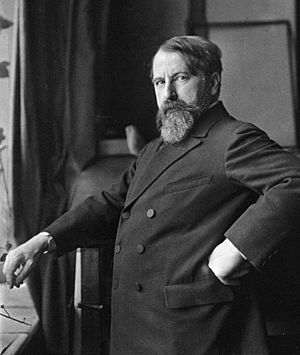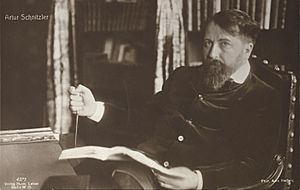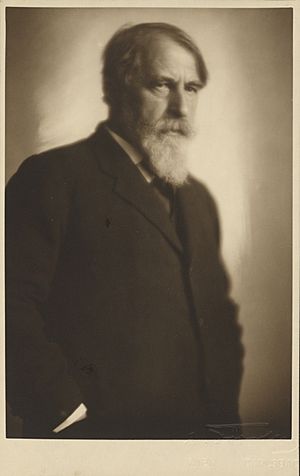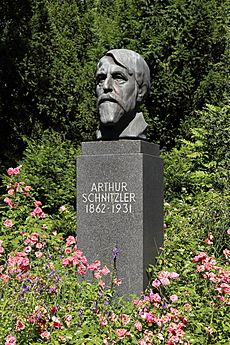Arthur Schnitzler facts for kids
Quick facts for kids
Arthur Schnitzler
|
|
|---|---|

Arthur Schnitzler, ca. 1912
|
|
| Born | 15 May 1862 Vienna, Austria |
| Died | 21 October 1931 (aged 69) Vienna, Austria |
| Occupation | Novelist, short story writer and playwright |
| Language | German |
| Nationality | Austrian |
| Genre | Short stories, novels, plays |
| Literary movement | Decadent movement, Modernism |
| Notable works | Dream Story, Reigen, Fräulein Else |
Arthur Schnitzler (born May 15, 1862, died October 21, 1931) was an important Austrian writer. He wrote many plays, short stories, and novels. His works often explored human feelings and society in Vienna, Austria, during his time.
Contents
Who was Arthur Schnitzler?
Arthur Schnitzler was born in Vienna, the capital of the Austrian Empire. His father, Johann Schnitzler, was a famous throat doctor. His mother, Luise Markbreiter, was the daughter of another doctor. Both of his parents came from Jewish families.
In 1879, Arthur began studying medicine at the University of Vienna. He earned his medical degree in 1885. He started working at Vienna's General Hospital. However, he soon decided to focus on writing instead of medicine.
Schnitzler's Family Life
On August 26, 1903, Schnitzler married Olga Gussmann. She was an actress and singer. They had a son named Heinrich, born in 1902. In 1909, they had a daughter named Lili, but she sadly died in 1928. Arthur and Olga separated in 1921.
Arthur Schnitzler passed away on October 21, 1931, in Vienna. He died from a brain hemorrhage. His son, Heinrich, later moved to the United States. Heinrich's son, Michael Schnitzler, is now a musician in Vienna.
What did Arthur Schnitzler write?
Schnitzler's writings often spoke out against unfair treatment of Jewish people. This can be seen in his play Professor Bernhardi and his novel Der Weg ins Freie.
Famous Plays and Stories
One of his most famous plays is Reigen. This play was made into a popular French film called La Ronde in 1950. Many other films and plays have been based on Reigen since then.
His short novel Fräulein Else (1924) is told from the point of view of a young woman. It shows her thoughts and feelings, which was a new way of writing at the time. This style is called "stream of consciousness." The story explores a difficult choice she faces, leading to a sad ending.
New Ways of Writing
Schnitzler was part of a group called Young Vienna (Jung-Wien). This group liked to try new things in writing. In 1900, Schnitzler wrote a short novel called Leutnant Gustl. It was the first German story written using the "stream of consciousness" style. This story showed the main character and the strict rules of the army in a critical way. Because of this story, Schnitzler lost his position as a reserve officer in the medical army. This happened partly because of the growing unfair treatment of Jewish people at that time.
Schnitzler was very good at writing shorter pieces. These included novellas (short novels) and one-act plays. He also wrote two longer novels. Der Weg ins Freie describes society in Vienna before World War I. Therese is another novel he wrote.
His Diaries and Letters
Besides his plays and stories, Schnitzler kept a detailed diary. He wrote in it from age 17 until just before he died. This diary is almost 8,000 pages long! Collections of his letters have also been published.
Works Banned by Nazis
Later, Adolf Hitler and the Nazis in Austria and Germany banned Schnitzler's works. They called his writings "Jewish filth." In 1933, the Nazis held public book burnings. Schnitzler's books were thrown into the flames along with those of other Jewish writers and thinkers.
What is Arthur Schnitzler's legacy?
Most of Schnitzler's writings and papers, about 40,000 pages, were saved from the Nazis. A British man named Eric A. Blackall helped protect them. He worked with the British embassy in Vienna. The Nazi government respected that they could not enter the cellar of Schnitzler's home where the documents were kept.
Later, these documents were given to the Cambridge University Library. However, Schnitzler's divorced wife, Olga, gave them away. She actually did not have the right to do this. The real owner was Schnitzler's son, Heinrich, who was not in Vienna at the time.
After World War II, Heinrich Schnitzler tried to get the documents back. But he was not successful. In 2015, a newspaper article suggested that the documents should be returned to Schnitzler's family. His grandsons, Michael and Peter, then said they wanted the documents back.
Selected Works
Plays
- Anatol (1893)
- Flirtation (Liebelei – 1895)
- Fair Game (Freiwild – 1896)
- Light-'O-Love (1896)
- Reigen (1897), also known as La Ronde
- Die Gefährtin (1899)
- Paracelsus (1899)
- The Green Cockatoo (Der grüne Kakadu – 1899)
- The Lonely Way (Der einsame Weg – 1904)
- Intermezzo (Zwischenspiel – 1904)
- Der Ruf des Lebens (1906)
- Countess Mizzi or the Family Reunion (Komtesse Mizzi oder Der Familientag – 1907)
- Living Hours (1911)
- Young Medardus (Der junge Medardus – 1910)
- The Vast Domain (Das weite Land – 1911)
- Professor Bernhardi (1912)
- Comedies of Words and Other Plays (1917)
Novels
- The Road into the Open (Der Weg ins Freie – 1908)
- Therese. Chronik eines Frauenlebens (1928)
Short stories and novellas
- Dying (Sterben – 1895)
- None but the Brave (Leutnant Gustl – 1900)
- Berta Garlan (1900)
- Blind Geronimo and his Brother (Der blinde Geronimo und sein Bruder – 1902)
- The Prophecy (Die Weissagung – 1905)
- Casanova's Homecoming (Casanovas Heimfahrt – 1918)
- Fräulein Else (1924)
- Rhapsody – also published as Dream Story (Traumnovelle – 1925/26)
- Night Games (Spiel im Morgengrauen – 1926)
- Flight into Darkness (Flucht in die Finsternis – 1931)
- The Death of a Bachelor
- Late Fame (2014)
Nonfiction
- My Youth in Vienna (Jugend in Wien), an autobiography published after his death in 1968
- Diary, 1879–1931
See Also
 In Spanish: Arthur Schnitzler para niños
In Spanish: Arthur Schnitzler para niños






